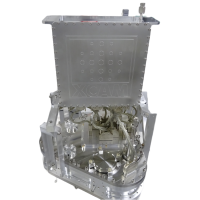UK based XCAM Ltd, leaders in specialist digital camera systems, has delivered an advanced digital camera to Pennsylvania State University (PSU) in the USA, as part of a multi-million-dollar NASA space technology project that will see the system launched into space on a sub-orbital sounding rocket as part of the OGRE mission in 2025.

Image Credit: XCAM Ltd
The Off-Plane Grating Rocket Experiment (OGRE) aims to increase the technology readiness levels for future space missions of a soft X-ray spectrometer made up of three new space technologies which have not flown in space before. One of these is the Electron Multiplying CCD camera designed and built by XCAM to capture X-ray photons from the target object; the Capella star system. The other two components include a unique Silicon Grazing Incidence X-ray Mirror, being developed at NASA's Goddard Space Flight Center and Off-Plane Reflection Gratings using X-ray Diffraction being developed at PSU.
Karen Holland, CEO of XCAM Ltd, explained, "Our specialist digital cameras have a worldwide reputation for excellence. We are excited and pleased to have been chosen by Pennsylvania State University and to be working alongside NASA as part of this new advanced space technology demonstration mission."
The OGRE mission consists of a 12.2 meter NASA Black Brant IX sounding rocket that will carry the three components on a suborbital trajectory into space for about 10 minutes before returning to Earth. During its time in space, it will collect approximately 500 X-ray photons from the Capella star system. The resulting data will be compared with X-ray data from the same star system captured by existing space-based X-ray spectrometers (e.g. NASA's Chandra observatory). Comparing the data from these different instrument should demonstrate the readiness of these three new technologies for use in future flagship space missions to perform astronomical X-ray measurements.
The EMCCD digital camera system from XCAM was developed in the UK and the OGRE flight will be the first time it will be used in space. The camera system consists of four Teledyne e2v Electron Multiplying CCDs that are able to greatly amplify the signal in each pixel before the pixels are read out (thus increasing the signal-to-noise ratio). The camera will be open to the vacuum of space and cooled to -100?C during flight, and the captured X-ray photon data will be downloaded in real time.
James Tutt, Assistant Research Professor at Pennsylvania State University, commented, "We build a large number of X-ray spectrometers for use on sub-orbital rocket flights. Often we build the majority of the instrument ourselves, but sometimes we collaborate with other institutions or use companies to develop parts of the instrument. Working with XCAM, even though they are a company, has felt more like a collaboration. They have been flexible in working with us through many changes in the camera design, have kept us informed every step of the way in the progress of the camera build (even through a global pandemic), and have delivered the camera system on time.
We never had any concerns with using XCAM as our camera provider due to their excellent reputation in developing complex digital cameras systems for space technology and due to our previous experience working with them on the development of a CCD-based X-ray spectrometry camera."
XCAM designs and manufactures highly specialized complex digital camera systems for challenging scientific, environmental and space applications. They are one of only a few companies in the world to offer complete imaging sensor camera solutions. XCAM have a worldwide reputation for their ability, reputation, expertise, and outstanding knowledge in the field.